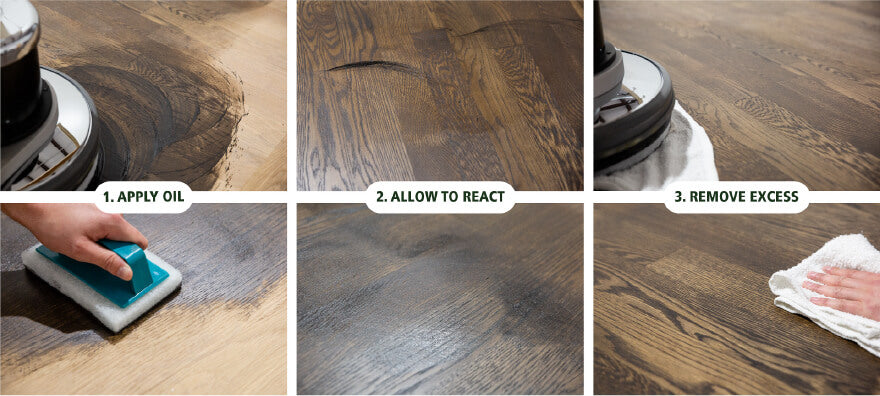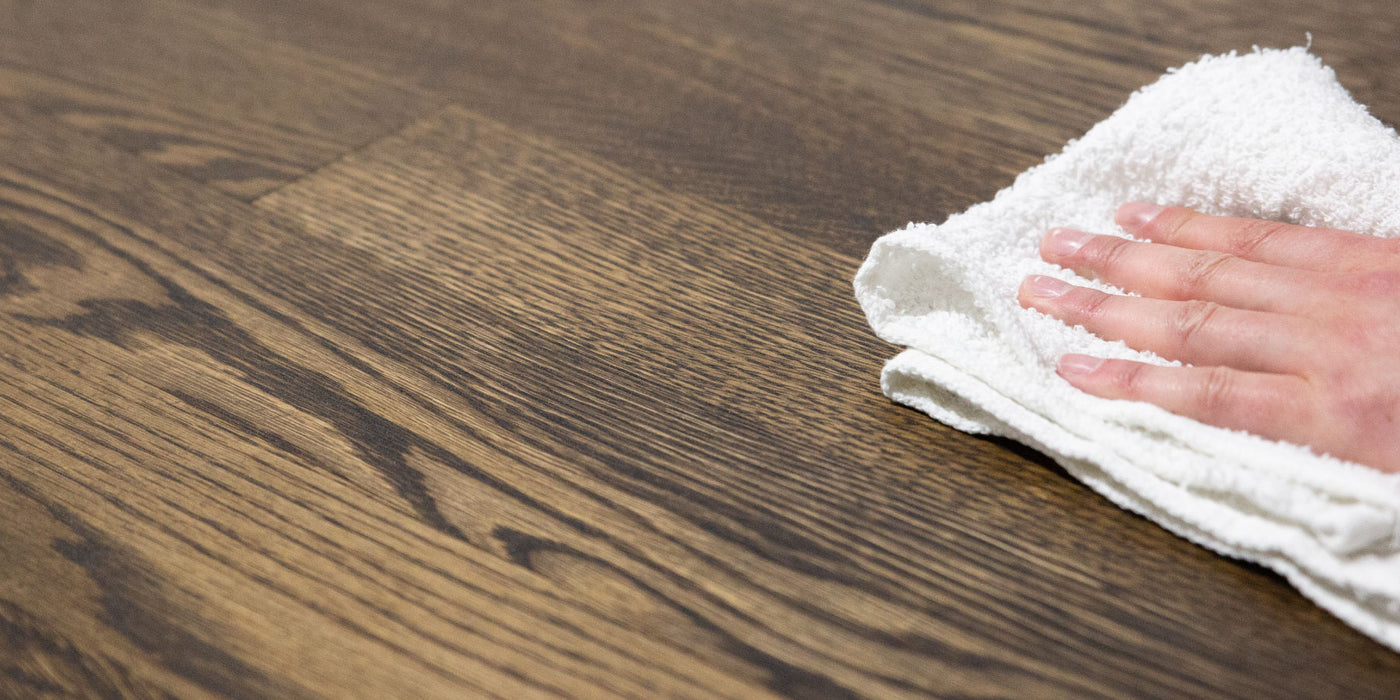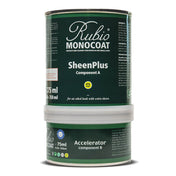Introduction
Hardwax oil, sometimes spelled hard wax oil, wood finishes are typically manufactured from a mix of one or more vegetable oils and one or more waxes; the formulation may also contain a range of additional chemicals like solvents (VOCs), drying agents and pigments for color.
European by origin, hardwax oils have been steadily gaining popularity in the North American market. Today, hardwax oils are a popular option when choosing a wood finish.
Hardwax oil finishes provide an aesthetically pleasing and very natural appearing finishing method without forming a “plastic” like film on the wood (which obscures the grain and texture of the wood).
Origin and History
Before varnishes and polyurethanes were developed to protect and beautify wood substrates, wood substrates were often protected and preserved with pine tar or other oily substances. In the latter part of the 1800s, it was discovered that linseed oil provided good protective properties when applied to wood. When linseed oil was used to beautify and protect wood, it was typically followed by an application of beeswax to enhance the appearance and to make the wood more resistant to moisture, dirt, and grime. However, this combo was not very practical as the wax on the surface gave little additional protection and required extensive and frequent maintenance.
In the 1990s, the first hardwax oil products (where oils and waxes were combined in one product) were developed in Europe and made their way into the wood finishing market.
Uses of Hardwax Oil
Hardwax oils may be used for beautifying and protecting wood surfaces like; wood flooring, wood millwork, wood furniture, wood countertops, wood cabinetry, wooden toys, wooden food presentation platters (when certified for food-safe use) and other wood-like substrates like cork or wood fiber panels.
Hardwax oils are formulated for both interior and exterior applications.
Formulation
Oils
The oil used in hardwax oil products is typically a vegetable based oil like linseed oil, which is pressed from the seed of flax plants. Linseed oil has a very small molecule size, which penetrates easily into the wood cells.
Other oils used in a formulation of hardwax oils may be; safflower oil, soy oil, tung oil, thistle oil, and others.
Wax
Besides the oil, hardwax oil also contains natural hardening waxes.
Single-Component or Two-Component
There are both single-component and two-component hardwax oils.
Single-component hardwax oil products are oxidative, which means they dry and cure by reacting with oxygen present in the air. This curing process may take up to 30 days before a complete cure has taken place. During the curing period, hardwax oils should not be exposed to liquids.
Two-component hardwax oil products cure through two reactions. They use the same oxidative curing process as single-component and additionally, a chemical process from the additive component. The additive component causes the oil resin to cure at a much faster rate than just the oxidative (airdrying) process alone. Two-component hardwax oil products typically dry and cure in less than a week.
This means wood surfaces finished with two-component hardwax oil finishes may be put in service sooner than single component versions. Two-component hardwax oil products provide overall better chemical, liquid resistance, and performance than the one-component versions.
VOC Content
Volatile organic compounds (VOCs) are organic chemicals that have a high vapor pressure at ordinary room temperature. Their high vapor pressure results from a low boiling point, which causes large numbers of molecules to evaporate or sublimate from the liquid or solid form of the compound and enter the surrounding air, a trait known as volatility.
VOCs are numerous, varied, and ubiquitous. They include both human-made and naturally occurring chemical compounds. Most scents or odors are of VOCs. Some VOCs are dangerous to human health or cause harm to the environment. Anthropogenic VOCs are regulated by law, especially indoors, where concentrations are the highest. Harmful VOCs typically are not acutely toxic, but have compounding long-term health effects. Because the concentrations are usually low and the symptoms slow to develop, research into VOCs and their effects is difficult. (Wiki)
Some hardwax oils contain 0% VOCs while others contain differing amounts.
Solid Content
The solid content of a hardwax oil wood finish is typically determined by how much product remains on the wood substrate after drying and curing, and how much evaporates (solvents). The more material that remains on the wood and fewer ingredients evaporate during the curing period, the higher the solid content. When no solvent evaporates, the product is considered a 100% solids product.
Hardwax oil products with high solids often translate into high yields and good coverage/spread rates.
Chemical Sensitivities
Some people are sensitive to the chemicals in wood finishing products, often to the ingredients that evaporate. 0% VOC hardwax oils are therefore a more logical option and are often chosen for a wood finishing project by, or for people with chemical sensitivities.
Some manufacturers may have certifications available that certify their product to be food-safe, safe for use on wood toys, or certified for healthy indoor air quality.

Application
Ease of Application
Hardwax oils are applied different than traditional wood finishing products (that get brushed or sprayed). Although the process is different, it is straightforward to complete and does not require the craftsman's skills needed for professionally brushing or spraying a wood finish.
Most hardwax oil products call for applying the product to the surface, allowing a few minutes to saturate the wood, and thoroughly removing the remaining excess product using absorbent cloths or towels.
On wood floor applications, typically, the use of large electric floor buffers is utilized for the application process. On smaller projects, the application commonly gets performed by hand or using smaller electric tools like a random orbit sander or small buffer. Some hardwax oil products may require a roller application and leave a thin film application without wiping.
Each hardwax oil product has its recommendations for a proper application and which tools to use. It is always recommended to check the manufacturers Technical Data Sheets (TDS) for the most accurate product information.
Coats Required
Based on the technology and formulation of a product, some hardwax oils may be applied as a single coat application while others require multiple applications.
Dry and Cure Times
Dry time refers to the amount of time it takes for an applied product to dry enough before it may be carefully handled or walked on. This usually takes between 24-72 hours.
Cure time is the amount of time it takes to cure completely. This may be less than a week for two-component hardwax oil products or up to a month for single-component products.
All hardwax oil applications need to maintain favorable drying and curing conditions. Key factors include temperature, humidity, and airflow. Cool temperatures, higher relative humidity levels, and poor airflow will delay good drying and curing!
Sanding Note:
It is imperative with the use of any hardwax oil product that the sanding process is executed very well. Any sanding deficiencies can be highlighted during the application of a hardwax oil, particularly if applying a colored oil.
This does not mean that one needs to finish with very fine grit sandpaper but instead finish the sanding with a grit that leaves the wood open enough to allow the oil to penetrate evenly. Too fine of a grit selection polishes and closes the prepared wood, which means little oil will be able to enter the wood cell structure.
The more oil that can enter the wood, the better the degree of protection and longevity. When sanding is performed too fine, the amount of oil being able to enter the wood will be restricted, and the protection and durability will also be affected.
Consult with the manufacturer of the hardwax oil about what the proper sanding grit and process should be.
Benefits of Using a Hardwax Oil
- Ability to achieve matte sheen all the way to satin sheen.
- Keeps the natural look and feel of wood.
- Does not build up a film over the wood.
- Typically environmentally friendly.
- Many color options.
- Great wear-, water- and heat resistance.
- Will never peel or flake.
- Good stain resistance.
- When properly maintained, does not require sanding and refinishing.
- Will never develop White-Line Syndrome.
Care Process
DO: General cleaning using a dry duster, vacuum, water, or manufacturer recommended cleaner.
DO: Perform recommended maintenance per manufacturers recommendations.
DON'T: Damp clean until completely cured.
DON'T: Completely saturate the surface with cleaner.
DON'T: Use generic cleaning products. They can compromise the finish.
DON'T: Leave standing liquid on the surface for extended periods of time.
General Cleaning
General cleaning should be performed on an as needed basis. Dry dusting or vacuuming is enough in most cases. If needed, damp mop or damp clean an oiled surface with the recommended cleaning solution. You should never use excessive amounts of the recommended cleaning solution.
Tip: Some manufacturers include oils in their soap that will “feed” the surface. Consistent use of their soap is critical to maintaining the surface.
As with all wood floors, it is recommended to tend to spills in a timely manner.
Maintenance
One major advantage of hardwax oil finishes is that when properly maintained, they can last a lifetime without needing to be sanded and refinished.
When the surface begins to look dry or thirsty, maintenance is necessary. Maintenance typically makes the surface look freshly finished, without requiring sanding. On average, maintenance of floors or tabletops may need to happen once every 3-5 years. Maintenance frequency varies and depends on use, care and climate.
When maintained properly, hardwax oiled surfaces, will last a "lifetime," and will look more beautiful as time goes on. Minor blemishes that may appear become part of the "patina" and add to the surfaces character, just like when one has a beautiful leather sofa, jacket, or briefcase that requires similar care.
Maintenance of hardwax oils is easier, more convenient and less time-consuming than maintaining a traditional film forming finish like polyurethane.
Repairability
Localized repairs can be performed on hardwax oil surfaces. This is significantly easier, faster, and cheaper than repairing surfaces that are finished with traditional film forming finishes, which typically require a complete re-sanding and re-finishing of the whole floor to repair minor scratches or damage satisfactorily.
Disadvantages
Comparing hardwax oil to polyurethane is like comparing apples to oranges. That being said, this is often the comparison being considered so we will take this approach.
Hardwax oil finishes do not form a film on the surface. While this is beneficial in many ways (aesthetically and allowing for repairability), it does come at a cost. The surface will be susceptible to chemicals and liquids sooner than a polyurethane floor, which has layers of plastic built up on top of the wood.
When hardwax oil wood surfaces are not appropriately maintained, it becomes more susceptible to dirt and spot retention.
For further information, read about hardwax oil vs polyurethane.
Safety
As with all oil-based wood finishing products, hardwax oils are capable of spontaneous combustion.
Please dispose of oil saturated materials properly, and in accordance with local regulations.


